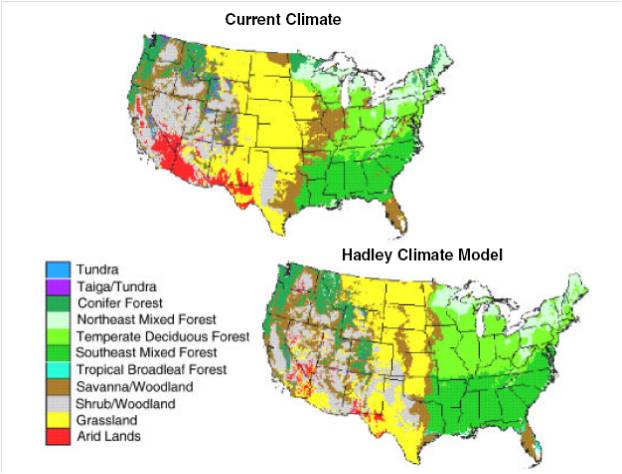Gimme Shelter
Climate Refugia

This article builds on last week’s review of some of the regional activities needed to address biodiversity loss. One particular challenge today is identifying and protecting climate refugia in areas that are known as hot spots for threatened biodiversity.
“Climate refugia” is a term that has emerged in the conservation biology literature. A refuge area is important for human beings as well as other animals during a period of major climatic disturbance (such as a period of glaciation). Climatic disturbance often includes a change in such environmental conditions as water and food availability. Our region can play an important role in developing adaptive conservation strategies to better protect endangered species in an era of climate change.

Overall, there is a lack of adaptation policy that is region- or ecosystem-specific for enabling the ecological resilience of threatened biodiversity. Current strategies include prescriptions at the state and federal government levels that support principles of ecosystem-based planning. Such planning includes the establishment of habitat reserves that support connectivity or migration corridors, habitat buffer zones, ecological core areas, the control of nonnative invasive species, and collaboration across administrative, economic, and political jurisdictions.
Local land-use planning and policy can play a fundamental role in protecting sensitive habitat areas and ecosystems. This should include the protection of rural lands that often support species diversity.
Resource managers increasingly recognize that adaptive policy must occur at regional levels. Recent studies show that the native plants unique to California are very vulnerable to global climate change, such that two-thirds of these “endemics” could suffer more than an 80 percent reduction in geographic range by the end of the century. Protecting endangered species and their habitats on private and public lands will become increasingly difficult as plants, animals, and insects adjust their ranges in response to climate change.
Conservation effort is needed to protect endangered species in parts of their habitat range that are relatively stable climate refugia — areas that function as important source areas from which species can expand given climate disturbance. Evidence is accumulating that emphasizes the importance of managing climate refugia that have historically supported ecological resilience during periods of dramatic climate disturbance, such as long-term changes in environmental conditions. The impacts from climate change on a range of ecosystems are increasingly a concern of state and local policymakers.
California may be on the verge of establishing a new era of conservation policymaking that may influence how we can protect endangered species in the context of climate disturbance. During the past several years, the California Legislature adopted 13 bills and Governor Schwarzenegger signed four executive orders to provide greenhouse gas producers and regulators with direction regarding required reduction activities. For example, the Global Warming Solutions Act of 2006 (enacted through Assembly Bill 32) established California as a national leader in terms of establishing clear targets for reducing such emissions.
A primary component of AB 32 was the establishment of a state greenhouse gases reduction target of 15 percent by 2020, to reach 1990 GHG emission levels, and 80 percent below 1990 levels by 2050. The California AB 32 Scoping Plan, completed in June 2008, contains the main strategies the state is using. The Scoping Plan proposed 18 emission-reduction measures, with the final reduction measures adopted in 2011. These measures seek to implement AB 32’s goal of framing a new statewide policy that outlines specific strategies and actions. So as to reach the 2020 target, these measures became legally enforceable at the beginning of 2012.
In response to the California policy framework, local authorities are required to develop Climate Action Plans or CAPs to comply with state laws. To date, few local authorities have completed the amendment process to their Local Coastal Plans (or LCPs) and General Plans. Since 2008, a number of cities and counties have begun to amend their General Plans and LCPs to include elements that address climate change. A recently published study found that in the entire 189-city Southern California Association of Government region, 64 cities were engaged in some type of climate-planning activity. Forty-nine cities have greenhouse-gas reduction targets in place in Southern California, and one city, Santa Monica, has adopted a general plan element that addresses climate change.
Another major component of the state’s climate policy framework is the 2009 California Climate Adaptation Strategy (CAS), a ground-breaking plan that will guide California’s future efforts in adaptive coastal planning. I encourage readers to review this important strategic document, since major changes in state and local policy are likely to result from it. The Climate Adaptation Strategy encourages future changes in the California Coastal Act and the California Environmental Quality Act with the goal of protecting habitats and species. The CAS is a direct response to Governor Schwarzenegger’s November 2008 Executive Order S-13-08 requesting state resource agencies to identify how state and local authorities can respond to rising temperatures, changing precipitation patterns, sea level rise, and extreme natural events.
The production of the CAS included the work from six Climate Adaptation Working Groups that collaborated to identify and prioritize climate adaptation strategies on a per-sector basis. The Oceans and Coastal Resources Working Group contributed to the CAS by describing a range of expected impacts. The following major impacts are identified in the CAS: increased temperature, invasive species, changes in community composition and interactions, ecosystem services, precipitation changes and extreme weather events, coastal flood and permanent inundation, wetland loss and habitat degradation, increased coastal erosion, saltwater intrusion, and sea-level rise.
During the last several years, local planners in Santa Barbara County have begun the development of our Climate Action Strategy (see this link). The approach adopted thus far has been rather conventional. Yet, ahead of other counties and cities, Santa Barbara County has identified the important strategy of protecting biodiversity with respect to climate change, due in part to the wisdom and leadership of Supervisor Janet Wolf. However, during the past two years, the focus has been on responding to the state’s legal requirements to reduce greenhouse gas emissions. The current legal requirements do not include that local policymakers address new plans for biodiversity loss due to climate-related events.
We should certainly take the opportunity to protect biodiversity for areas like the Gaviota coast. Later this year, the county will produce a draft Gaviota Coast Plan for public discussion (see this link). We have an opportunity today to set an important precedent in California — we need to broaden the scope of local coastal plans to include new biodiversity protection and land-use elements that address the anticipated impacts from climate change on coastal ecosystems.
The 2009 California Climate Adaptation Strategy provides a number of important land-use strategies to protect species at the local level. While reducing greenhouse gas emissions is an important first step, it is not enough. We also need to better understand the inherent values of protecting biodiversity and the ecosystem services that healthy ecosystems provide. Protecting species requires new partnerships that cut across private and public interests, and new social alliances between farmers, ranchers, conservationists, and community activists. I encourage the citizens of this county to become more aware of the threats that we face in an era of climate change, and to work with county planners and policymakers to develop a local approach to biodiversity loss that we can be proud of.


